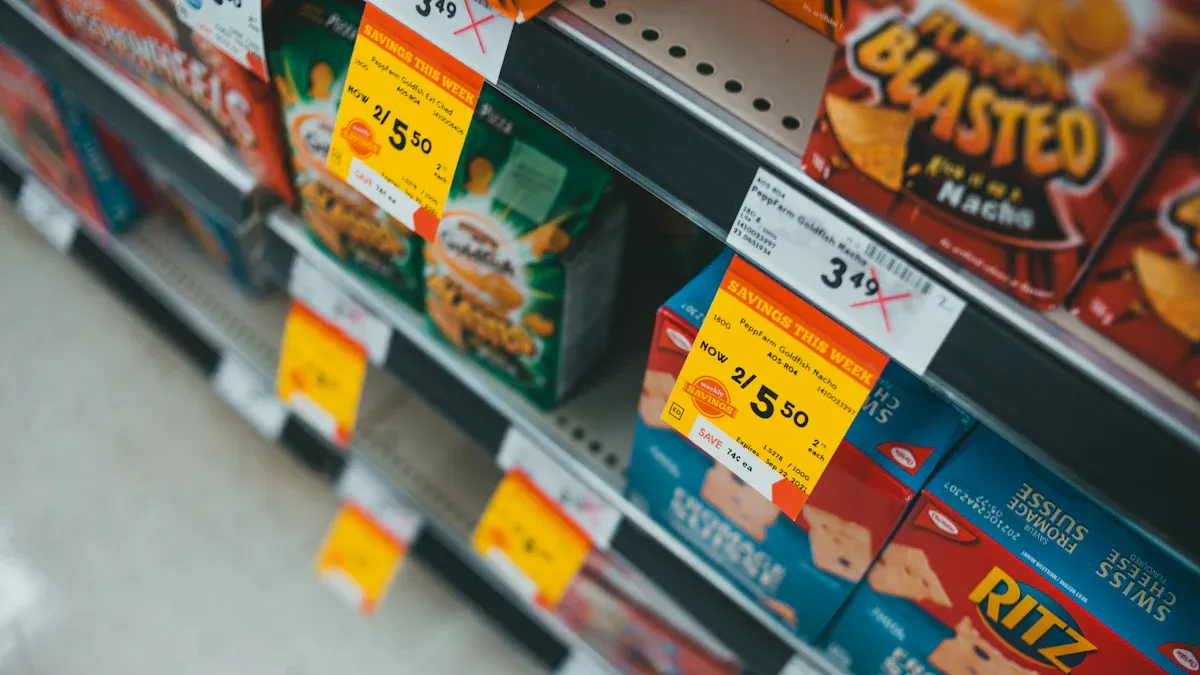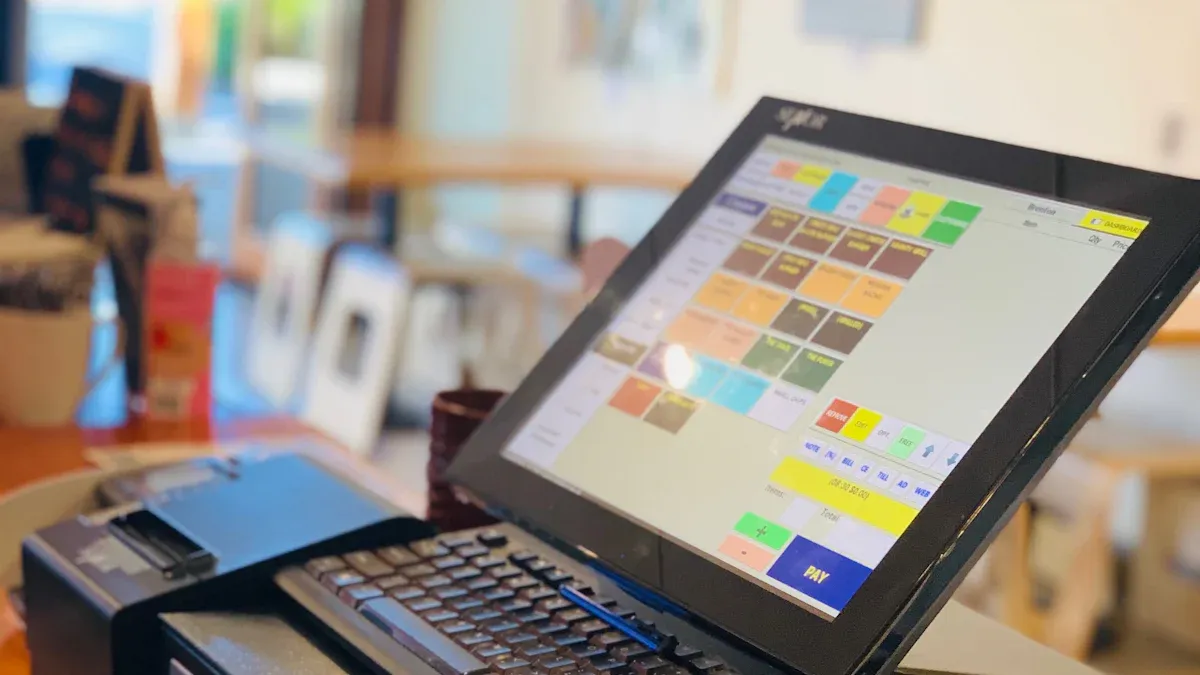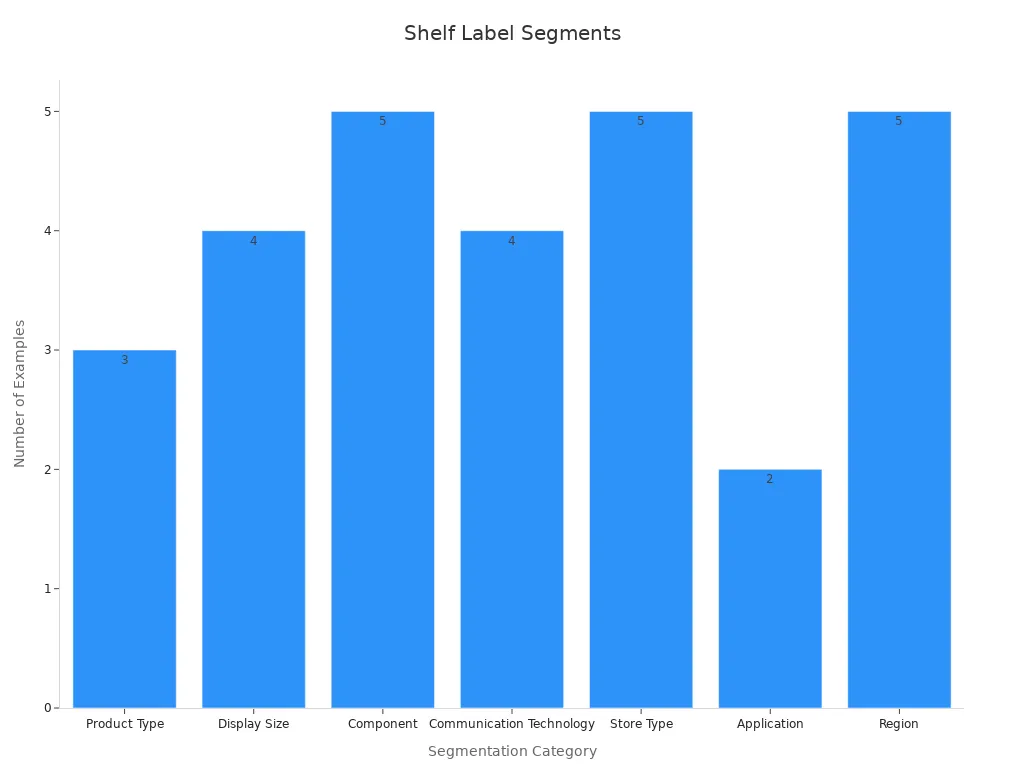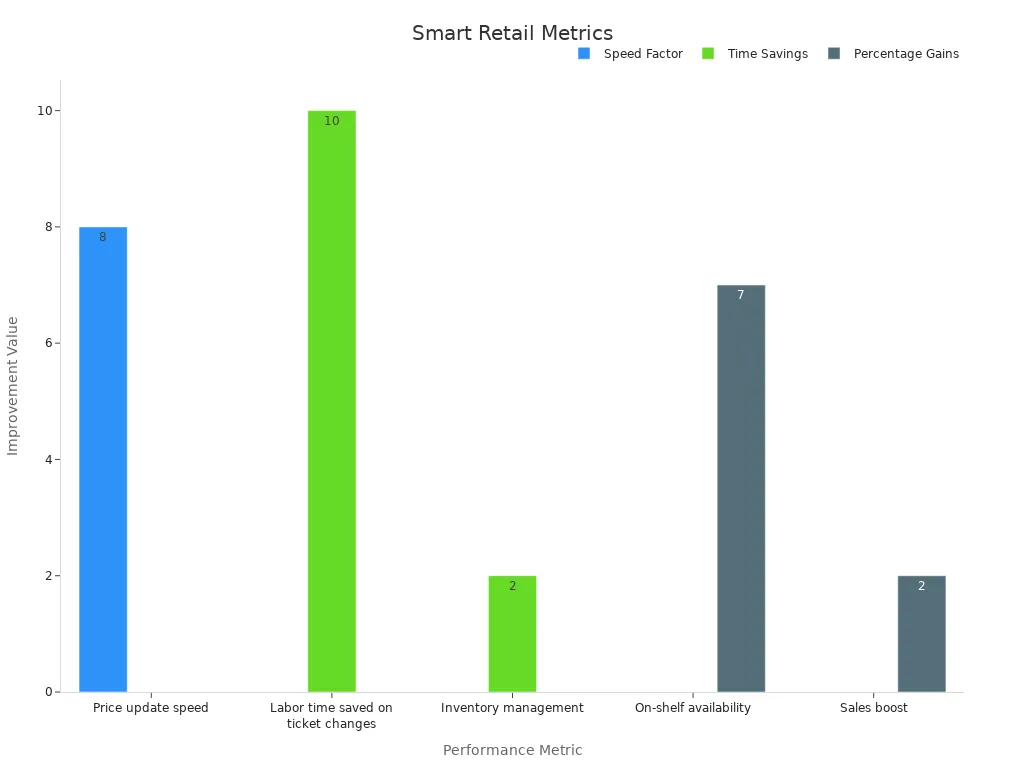
Electronic shelf labels transform retail efficiency by automating price updates and minimizing errors. Stores using ESL Price Tag systems report a 98% reduction in pricing mistakes, as shown below:
| Metric Description | Numerical Improvement |
|---|---|
| Pricing errors reduction in a grocery store chain | 98% reduction |
Labor costs related to label changes drop by up to 90%, freeing staff to focus on customer service and supporting streamlined operations. The ESL Gateway AP and Esl Retail platforms help retailers realize the benefits of electronic shelf labels, ensuring accurate pricing and greater efficiency.
What Are Electronic Shelf Labels?

Definition and Core Features of Electronic Shelf Labels
Electronic shelf labels represent a major advancement in retail technology. These small, battery-powered devices replace traditional paper tags at the shelf edge. Most electronic shelf labels use e-paper displays, which offer high contrast and energy efficiency. Retailers rely on these labels to automate pricing management, display product information, and support promotions. Digital shelf labels also enable proximity services and order picking, making them essential for modern retail operations.
Digital Display Technology in Electronic Shelf Labels
Digital shelf labels use advanced display technologies such as e-paper and LCD screens. E-paper displays dominate the market due to their readability and low power consumption. These displays provide clear visibility from different angles and allow for customization, which enhances the customer experience. Digital shelf labels can also integrate pick-to-light features, guiding staff and customers to products with illuminated indicators. This technology improves picking accuracy and reduces restock time.
Wireless Communication for Real-Time Price Updates
Digital shelf labels connect to a central system using wireless technologies like Bluetooth, radio frequency, or Wi-Fi. The Bluetooth Core 5.4 standard, for example, supports secure and scalable communication. This wireless network enables real-time price updates, ensuring that shelf prices always match the checkout system. Retailers benefit from dynamic pricing automation, which streamlines pricing management and reduces manual errors.
How Digital Shelf Labels Work in Retail Environments
Digital shelf labels operate as part of a larger retail ecosystem. They integrate with point-of-sale (POS) and inventory systems, allowing for seamless data flow. This integration ensures that pricing management remains consistent across all channels.
Integration with POS and Inventory Systems
Retailers connect digital shelf labels to their POS and inventory management platforms. This connection allows for automatic updates of prices and product information. When inventory levels change or promotions launch, digital shelf labels reflect these changes instantly. The system also supports stock level displays and alerts for restocking, improving operational efficiency.
Centralized Price Management and Control
Centralized software manages all digital shelf labels in the store. Retailers can update prices, launch promotions, and monitor inventory from a single dashboard. This centralized approach ensures consistency and accuracy in pricing management. Digital shelf labels also support dynamic pricing strategies, allowing retailers to adjust prices based on demand, inventory, or competitor activity.
Types of Electronic Shelf Labels
Retailers can choose from several types of electronic shelf labels, each designed for specific needs. The main types include LCD, segmented e-paper, and full-graphic e-paper labels. Display size varies from less than three inches to over ten inches, depending on the application.
| Segmentation Category | Examples |
|---|---|
| Product Type | LCD, Segmented E-Paper, Full-Graphic E-Paper |
| Display Size | <3 inch, 3-7 inch, 7-10 inch, >10 inch |
| Component | Displays, Batteries, Transceiver, Microprocessors, Others |
| Communication Technology | Radio Frequency, Infrared, Near Field Communication (NFC), Others |
| Store Type | Hypermarkets, Supermarkets, Non-Food Retail Stores, Specialty Stores, Others |
| Application | Retail, Industrial |
| Region | North America, Europe, Asia-Pacific, Middle East & Africa, LATAM |

E-paper vs. LCD Digital Shelf Labels
E-paper digital shelf labels lead the market because of their energy efficiency and superior readability. LCD digital shelf labels offer vibrant colors and faster refresh rates, making them suitable for promotional displays. Retailers select the type based on shelf location, lighting conditions, and information requirements.
Battery Life and Durability of Electronic Shelf Labels
Digital shelf labels are designed for long battery life, often lasting several years. E-paper models consume power only during updates, which extends battery performance. Some digital shelf labels use solar cells or wireless charging to further increase lifespan. Durability remains a key feature, as these devices must withstand daily handling and environmental changes in retail settings.
Benefits of Electronic Shelf Labels for Retailers
Real-Time Price Updates and Dynamic Pricing
Instant Synchronization with Central Systems
Retailers gain a significant advantage from the benefits of electronic shelf labels through instant synchronization with central systems. These systems allow stores to update thousands of prices across multiple locations in minutes. Walmart, for example, uses electronic shelf labels to complete price changes that once took days in just a few minutes. This rapid process increases productivity and ensures accuracy and consistency between shelf and checkout prices.
- ESLs automate price updates, reducing labor and pricing errors.
- They save on paper, ink, and staff time, allowing employees to focus on higher-value tasks.
- ESLs improve order picking efficiency with geolocation and LED indicators, saving time per pick.
- Inventory management benefits from real-time stock alerts and restocking guidance, which helps prevent stock-outs and improves customer retention.
- Promotion management becomes faster and more effective with automatic price updates and color-coded labels to highlight deals.
Fast Response to Promotions and Market Changes
The benefits of electronic shelf labels extend to dynamic pricing and fast responses to market changes. Retailers can implement dynamic price adjustments and real-time pricing strategies, responding to competitor activity, inventory levels, or demand spikes. A UK grocery chain increased its price change frequency from once every 1.5 months to every three weeks after adopting ESLs, which correlated with higher revenue. Combining ESLs with expanded bar codes enabled daily dynamic pricing, reducing product waste from 20-30% to nearly zero. This approach led to increased revenues and profits by moving more product quantity. Large supermarket chains in China also reported that dynamic pricing stabilized ordering patterns and reduced waste, counteracting supply chain volatility.
Reduce Pricing Errors and Ensure Consistency
Eliminating Manual Price Changes
Manual price changes often lead to pricing errors, lost sales, and customer frustration. The benefits of electronic shelf labels include the ability to reduce pricing errors by automating updates and eliminating the need for manual intervention. According to the National Retail Federation, retailers saw a 30% reduction in pricing errors after switching to digital shelf labels, saving both time and resources. Automated pricing with ESLs can reduce labor costs by up to 80%, as staff no longer need to spend hours updating paper tags. For example, updating over 1,000 price changes weekly can consume more than eight hours of labor per store. By removing this burden, employees can focus on customer service and other critical tasks.
- ESLs ensure real-time price synchronization, eliminating pricing discrepancies that cause customer complaints, chargebacks, and compliance fines.
- Retailers save thousands annually by removing recurring printing and maintenance costs associated with paper price tags.
- Pricing errors lead to lost sales, customer frustration, and potential legal penalties, which ESLs help prevent by ensuring price accuracy.
- ESLs have a lifespan of up to 10 years, providing long-term durability and reducing replacement and maintenance expenses.
Consistency Across All Store Locations
Consistency in pricing remains essential for retailers with multiple locations. The benefits of electronic shelf labels include centralized control, which ensures accuracy and consistency across all stores. Retailers can launch promotions, adjust prices, and manage inventory from a single dashboard. Carrefour reported an 80% reduction in label maintenance time and 50% fewer pricing errors after deploying ESLs. Tesco experienced improved stock management and pricing efficiency, resulting in higher productivity and revenue. These results highlight how electronic shelf labels support pricing integrity and consistency, which are critical for building customer trust and maintaining compliance.
Enhanced Compliance and Transparency
Meeting Legal Pricing Requirements
Retailers must comply with strict legal requirements regarding price accuracy. The benefits of electronic shelf labels include automated, real-time price updates that help stores meet these regulations. By ensuring shelf prices always match checkout prices, retailers avoid costly fines and legal disputes. Automated systems also provide audit trails, making it easier to demonstrate compliance during inspections.
Building Customer Trust with Accurate Pricing
Accurate pricing builds customer trust and loyalty. The benefits of electronic shelf labels include eliminating pricing errors and ensuring transparency at every touchpoint. Walmart’s focus on data accuracy with digital shelf labels contributed to a 25% decrease in product return rates. Real-time price updates reduce consumer frustration caused by mismatches between in-store and online prices. Retailers using ESLs generally report higher profit margins, faster inventory turnover, and better employee productivity. As a result, customers experience greater satisfaction, and retailers strengthen their reputation for reliability.
How Electronic Shelf Labels Reduce Costs
Lower Labor Costs with Digital Shelf Labels
Reducing Manual Price Tag Changes
Digital shelf labels automate the process of updating prices, which eliminates the need for staff to manually replace paper tags. This automation leads to a significant reduction in labor hours dedicated to price changes. Grocery stores that have adopted digital shelf labels report that employees now spend less time on repetitive tasks and more time on activities that add value to the business. The integration of these systems with point-of-sale and inventory platforms further streamlines operations, allowing for instant price adjustments across thousands of products.
Retailers experience a notable drop in labor costs by removing manual price updates. This shift not only improves operational efficiency but also reduces the risk of pricing errors.
Freeing Up Staff for Customer Service
When digital shelf labels handle routine price changes, staff can focus on customer service and inventory management. Employees become available to assist shoppers, answer questions, and maintain store organization. This reallocation of labor enhances the overall shopping experience and supports higher customer satisfaction. In many cases, stores have reported improved staff morale as employees engage in more meaningful work rather than repetitive manual tasks.
| Benefit | Description | Payback Period |
|---|---|---|
| Labor Cost Savings | Significant reduction by eliminating manual price updates | 12 to 18 months |
| Increased Profitability | Long-term financial gains outweigh initial investment | N/A |
Saving on Materials and Printing
Eliminating Paper and Ink Expenses
Traditional price tags require regular printing and replacement, which consumes large quantities of paper and ink. Digital shelf labels remove this ongoing expense. Retailers no longer need to purchase printing supplies or allocate staff time to produce and distribute new tags. Over time, these savings contribute to a lower total cost of ownership for the store.
Reducing Waste and Environmental Impact
Switching to digital shelf labels also reduces waste. Fewer paper tags end up in landfills, and less ink is used, which lowers the store’s environmental footprint. Many retailers view this as an important step toward sustainability. The reduction in material usage aligns with green retail initiatives and supports a more eco-friendly operation.
- Digital shelf labels eliminate the need for paper and ink, reducing both costs and environmental impact.
- Less frequent tag replacement means less waste and a cleaner store environment.
- Retailers gain a competitive advantage by responding to consumer demand for sustainable business practices.
Long-Term ROI and Payback Period
Real-World Examples and Case Studies
Several retailers have documented the financial benefits of investing in electronic shelf labels. An international grocery retailer found that adopting digital shelf labels enabled more frequent and precise price changes, especially for perishable goods. This flexibility led to increased sales volume and higher profits. Stores reported labor reductions of up to three hours per week and a 30% decrease in pricing errors. These improvements contributed to operational cost savings and enhanced gross margins.
TRUNO’s analysis of a 30,000-tag system, with an initial investment of nearly $350,000, showed a payback period of two to three years. When paired with AI-based price optimization, the return on investment accelerated, sometimes reaching break-even in just one year. Other retailers, such as Naifeh’s Cash Saver and Maurer’s Market IGA, expect to recoup their investments in less than two years, while Houchens Food Group projects a payback period of about 3.5 years. These cases highlight the importance of labor savings, pricing accuracy, and operational efficiency in achieving long-term savings.
Calculating Total Cost of Ownership
The total cost of ownership for digital shelf labels includes the initial investment, ongoing maintenance, and potential upgrades. However, the reduction in labor, printing, and material costs quickly offsets these expenses. Retailers also benefit from fewer pricing errors, improved compliance, and enhanced customer trust. Over time, the long-term savings and increased profitability make electronic shelf labels a strategic investment for any retail operation.
Tip: When evaluating digital shelf labels, retailers should consider not only direct cost savings but also broader economic impacts, such as environmental benefits and improved staff productivity.
Additional Benefits of Electronic Shelf Labels
Improved Customer Experience with Digital Shelf Labels
Accurate Pricing at Checkout
Electronic shelf labels ensure that prices displayed on shelves always match those at checkout. This real-time synchronization eliminates confusion and prevents disputes at the register. Customers experience a seamless transaction, which builds trust and encourages repeat visits. Retailers also benefit from fewer pricing errors, which reduces the risk of compliance issues and improves operational efficiency.
Faster Response to Promotions and Sales
Retailers can launch promotions instantly across all store locations using ESLs. Price changes and special offers appear on shelves within minutes, allowing stores to react quickly to market trends or inventory levels. This agility supports more effective marketing campaigns and helps move products before expiration. Customers notice timely deals and enjoy a dynamic shopping environment, leading to improved customer satisfaction.
Sustainability and Eco-Friendly Operations
Reducing Carbon Footprint
Switching from paper tags to digital shelf labels significantly reduces paper and ink consumption. Retailers lower their carbon footprint by minimizing waste and cutting down on the resources needed for printing and distribution. ESLs also use energy-efficient technologies, such as e-paper displays, which require minimal power and further support sustainability goals.
Supporting Green Retail Initiatives
Many retailers now prioritize eco-friendly practices. ESLs align with these initiatives by reducing waste and supporting digital transformation. Stores that adopt ESLs demonstrate a commitment to environmental responsibility, which resonates with environmentally conscious shoppers. This approach not only benefits the planet but also enhances the retailer’s brand image.
Integration with Smart Retail Systems
Dynamic Pricing and Inventory Management
Modern ESLs integrate seamlessly with smart retail systems, enabling real-time updates for both pricing and inventory. Wireless network technology allows instant synchronization of price and stock information, reducing manual labor and errors. AI-driven systems analyze sales data and inventory levels to adjust prices dynamically, optimizing profit margins and reducing waste. The following table highlights key features and their operational impact:
| Feature Category | Description | Operational Impact |
|---|---|---|
| Real-time synchronization | Wireless updates for pricing and stock | Rapid, accurate adjustments; reduced manual labor |
| Digital display capabilities | Customizable, colorful digital labels | Enhanced product visualization and customer engagement |
| Detailed product information | Ingredients, specs, QR/NFC/barcode scanning | Improved customer experience; supports omnichannel integration |
Supporting Omnichannel Retail Strategies
ESLs play a vital role in omnichannel retailing. They provide detailed product information, including specifications and QR codes, which customers can scan for online ordering or additional details. Integration with inventory management systems ensures accurate stock data across all sales channels. Retailers can manage prices and promotions centrally, maintaining consistency in-store and online. The chart below illustrates performance improvements from integrating smart retail systems with ESLs:

Retailers report up to eight times faster price updates, increased on-shelf availability, and significant labor savings. These improvements lead to enhanced customer engagement and a more efficient retail operation.
Addressing Implementation Challenges of Electronic Shelf Labels
Upfront Costs and Budget Considerations
Initial Investment vs. Long-Term Savings
Retailers often face significant upfront costs when adopting electronic shelf labels. The choice between E-Ink and LCD ESLs impacts both initial investment and long-term expenses. E-Ink ESLs require a higher initial outlay due to advanced technology, but they offer longer battery life and lower maintenance costs. LCD ESLs cost less per unit but need more frequent battery replacements and repairs. The following table summarizes these cost aspects:
| Cost Aspect | E-Ink ESLs | LCD ESLs |
|---|---|---|
| Initial Investment | Higher upfront cost | Lower upfront cost per unit |
| Battery Life | Up to 5 years | 1-2 years, frequent replacements |
| Maintenance Costs | Minimal | Higher due to battery swaps/repairs |
| Total Cost Over 5 Years | Lower total cost | Higher total cost |
Retailers must also budget for installation, software integration, and staff training. These factors can increase initial costs and delay the return on investment. However, E-Ink ESLs often deliver better long-term value, with many retailers achieving ROI within two to three years. Labor savings, improved pricing accuracy, and reduced paper costs contribute to this efficiency.
Financing and Leasing Options
To manage upfront expenses, many retailers explore financing or leasing options for ESL systems. These models spread costs over time, making the technology more accessible. Leasing can also include maintenance and upgrades, reducing unexpected expenses. Careful financial planning helps retailers balance immediate budget constraints with long-term operational gains.
Installation and Staff Training for Digital Shelf Labels
Rollout Timeline and Best Practices
Implementing ESLs requires a structured rollout plan. Retailers should assess store layouts, inventory size, and integration needs before installation. A phased approach minimizes disruptions and allows staff to adapt gradually. Best practices include piloting the system in select locations, gathering feedback, and refining processes before full deployment.
- Pilot programs help identify integration challenges early.
- Clear communication with staff ensures smoother transitions.
- Scheduling installations during off-peak hours reduces operational impact.
Ongoing Support and Maintenance
After installation, ongoing support becomes essential. Retailers benefit from vendor-provided maintenance, software updates, and troubleshooting services. Regular training sessions keep staff updated on new features and best practices. This support structure helps maintain system reliability and maximizes the benefits of digital shelf labels.
Compatibility with Existing Retail Systems
Software Integration and Upgrades
Integrating ESLs with existing point-of-sale and inventory systems can present challenges. Retailers may need custom software solutions or upgrades to ensure seamless data flow. Compatibility issues can increase costs and extend implementation timelines. Working closely with technology partners helps address these challenges and ensures smooth integration.
Future-Proofing Your Investment
Retailers should select ESL solutions that support future upgrades and new technologies. Scalable systems allow for easy expansion as business needs grow. Investing in flexible, upgradable platforms protects against obsolescence and ensures long-term value from the ESL investment.
Tip: Careful planning and collaboration with experienced vendors help retailers overcome implementation hurdles and unlock the full potential of electronic shelf labels.
Measuring the Impact of Electronic Shelf Labels
Key Performance Indicators for Pricing Accuracy
Tracking Pricing Accuracy Improvements
Retailers rely on several key performance indicators to measure the impact of electronic shelf labels on pricing accuracy. These indicators help managers assess improvements and guide future decisions. Common metrics include:
- Reduction in labor costs due to less manual price updating
- Pricing accuracy rate, which tracks errors before and after ESL adoption
- Sales performance during promotions, reflecting the effect of real-time price updates
- Customer satisfaction, based on shopper perception of price clarity and promotion visibility
By monitoring these indicators, retailers gain accurate and timely data to evaluate the effectiveness of their ESL systems. Consistent tracking ensures that pricing remains reliable and transparent for both staff and customers.
Monitoring Cost Reductions
Retailers often see measurable cost reductions after implementing electronic shelf labels. The ESL Gateway Software provides centralized management and real-time synchronization of price and content updates. This system reduces manual updates and errors, leading to lower operating costs and improved staff productivity. The software can manage up to 100,000 tags per store and integrates with ERP systems, which enables automation and streamlined operations. These features contribute to a clear return on investment and support ongoing efficiency improvements.
Feedback from Staff and Customers
Employee Productivity Gains
Electronic shelf labels free employees from repetitive manual tasks. Staff can focus on customer service and inventory management, which increases overall productivity. Centralized systems and automated updates reduce the time spent on price changes, allowing employees to engage in more meaningful work. This shift supports a positive work environment and helps stores operate more efficiently.
Customer Satisfaction Scores
Accurate pricing and clear promotions improve the shopping experience. Customers benefit from consistent prices at the shelf and checkout, which builds trust. Retailers often track customer satisfaction scores to measure the impact of ESLs on shopper perceptions. Higher scores indicate that customers notice and appreciate the improvements in price clarity and store organization.
Continuous Improvement and Optimization
Leveraging Data Analytics
Retailers use advanced data analytics tools to optimize pricing and promotions. Revology Analytics, for example, offers AI-driven solutions that integrate with ESL systems. These tools provide real-time pricing decisions, margin optimization, and dashboards for promotional ROI. Case studies show that retailers achieve measurable improvements, such as increased gross margins and profit gains, by using these analytics. Data from ESLs enables managers to make informed decisions and adapt quickly to market changes.
Scaling Across Multiple Locations
As retailers expand, they need solutions that support growth. Electronic shelf labels and their supporting software allow for easy scaling across multiple locations. Centralized management and integration with inventory and e-commerce systems ensure consistent pricing and streamlined operations. Retailers can synchronize data across all stores, maintaining high standards of accuracy and efficiency as their business grows.
Real-World Success Stories with Digital Shelf Labels

Case Study: Grocery Retailer Using Electronic Shelf Labels
Labor Savings and Error Reduction
Maurer’s Market demonstrates how electronic shelf labels transform store operations. Before adopting digital shelf labels, staff spent four days manually updating 1,400 price tags. After implementation, the same task required less than 10 minutes. This dramatic improvement resulted from real-time synchronization between shelf labels and the POS system, which eliminated pricing errors and ensured consistency at checkout. The store projected a return on investment between 1.5 and 2.5 years, with half of the savings coming from reduced labor and paper costs. Employees now spend about 80% less time on price updates, allowing them to focus on customer service and store presentation. Houchens Food Group piloted electronic shelf labels in two locations and calculated a 3.5-year ROI, confirming that labor and cost efficiencies scale across different store formats.
Several grocery retailers, such as Monoprix, Lee’s Discount Liquor, POCO, Westside Market NYC, and Walmart, have also adopted digital price tags. These retailers report improved pricing accuracy and labor efficiency. Wireless connectivity enables real-time price updates, which eliminates manual label changes and reduces human error. Integration with POS systems ensures shelf prices always match those at checkout, supporting pricing integrity and customer trust.
Customer Experience Improvements
Grocery stores that use electronic shelf labels provide a more reliable shopping experience. Customers see accurate prices on shelves, which match the prices at checkout. This transparency reduces confusion and builds trust. Employees, freed from repetitive tasks, can assist shoppers and maintain store organization. As a result, stores report higher customer satisfaction and smoother operations.
Case Study: Electronics Store and Real-Time Price Updates
Dynamic Pricing in Action
Electronics retailers benefit from electronic shelf labels by enabling real-time price adjustments. These systems allow stores to respond quickly to changes in demand, inventory, and competitor pricing. For example:
- Stores update thousands of labels in minutes, supporting rapid price changes.
- Real-time market data integration lets stores adjust prices based on competitor activity and stock levels.
- Staff spend less time on manual updates, focusing instead on customer service.
- Inventory turnover improves as slow-moving products receive timely discounts.
| Performance Metric | Description |
|---|---|
| Price Update Speed | Updates 3,000 labels in 5 minutes, enabling rapid price changes. |
| Real-time Market Data Integration | Adjusts prices dynamically using competitor prices and demand data. |
| Operational Efficiency | Reduces manual price changes, freeing staff for other tasks. |
| Revenue Optimization | Adjusts prices to boost sales or increase margins as needed. |
| Inventory Turnover | Discounts slow-moving items, maximizing profits on in-demand products. |
| Competitive Pricing Responsiveness | Swiftly reacts to competitor price changes, maintaining competitiveness. |
ROI Achieved Within One Year
Some electronics retailers achieve a return on investment within one year after deploying electronic shelf labels. The rapid price update capability and operational efficiencies drive this quick payback. Stores optimize revenue and reduce costs, making the technology a strategic asset.
Lessons Learned and Best Practices for Electronic Shelf Labels
Overcoming Implementation Hurdles
Retailers such as Walmart, Lidl, Target, Amazon Go, and L’Oréal have shared valuable lessons from their electronic shelf label deployments. They highlight the importance of careful vendor selection, pilot testing, and comprehensive staff training. Integration with legacy POS and inventory systems can present challenges, but phased rollouts and network upgrades help address these issues. Structured change management and readiness assessments support smooth transitions.
Maximizing the Benefits of Electronic Shelf Labels
Best practices include ongoing monitoring of system performance and continuous improvement through feedback. Retailers recommend maintaining regular staff training and communication. Sustainability gains, such as reduced paper waste and a lower carbon footprint, align with consumer expectations. Real-time price updates and improved shelf presentation enhance the customer experience. Retailers who follow these strategies report up to a 95% reduction in price update time and near elimination of pricing errors.
Retailers who invest in electronic shelf labels gain a clear advantage in today’s competitive market. These systems automate price updates, minimize errors, and drive efficiency across store operations. Retail analytics research shows that ESLs support real-time pricing, labor allocation, and demand forecasting. Key benefits include:
- Improved efficiency through automated processes and reduced labor costs
- Enhanced customer experience with accurate pricing and transparent information
- Support for sustainable practices by reducing paper waste
Electronic shelf labels position retailers for future-ready, data-driven operations.
FAQ
What is the typical lifespan of an electronic shelf label?
Most electronic shelf labels last between five and ten years. E-paper models often provide longer battery life due to low power consumption. Retailers can expect reliable performance throughout the device’s lifespan.
Can electronic shelf labels display more than just prices?
Yes, electronic shelf labels can show product information, promotions, barcodes, and QR codes. Some models support multiple languages and dynamic content updates, enhancing the customer experience and supporting omnichannel strategies.
How secure are electronic shelf label systems?
Manufacturers design electronic shelf label systems with strong encryption and secure wireless protocols. These measures protect data and prevent unauthorized access. Retailers should follow best practices for network security and regular software updates.
Do electronic shelf labels require frequent maintenance?
Electronic shelf labels need minimal maintenance. Most issues involve battery replacement or software updates. Retailers can schedule routine checks to ensure optimal performance and address any technical concerns promptly.
Are electronic shelf labels compatible with existing POS systems?
Most modern electronic shelf label solutions integrate with leading POS and inventory management systems. Retailers should verify compatibility with their current software before implementation to ensure seamless data synchronization.
How do electronic shelf labels support sustainability goals?
Electronic shelf labels reduce paper and ink usage, lowering waste and environmental impact. Retailers who adopt these systems demonstrate a commitment to eco-friendly operations and support broader sustainability initiatives.
What happens if the wireless network goes down?
Electronic shelf labels retain the last updated information during network outages. Once connectivity restores, the system automatically synchronizes any pending updates. This feature ensures price accuracy and operational continuity.
Can retailers update prices remotely across multiple stores?
Yes, centralized management platforms allow retailers to update prices and promotions remotely. This capability ensures consistency across all locations and streamlines pricing strategies for large retail chains.


